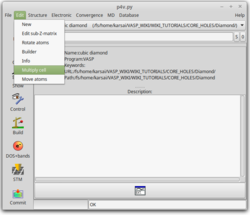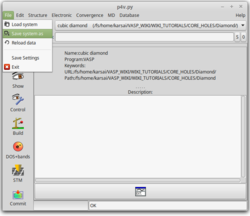XANES in Diamond: Difference between revisions
No edit summary |
|||
| Line 110: | Line 110: | ||
243.765042 0.000000 0.000000 0.000000 0.000000 0.000000 0.000000 | 243.765042 0.000000 0.000000 0.000000 0.000000 0.000000 0.000000 | ||
... | ... | ||
Usually we are interested in the sum of all components of the dielectric matrix. You can either obtain this by your script or you use the script provided in this example. If you decide for the latter use the command ''perl ./plot_core_imdiel.pl''. This will create the file CORE_DIELECTRIC_IMAG.dat which contains the summed up imaginary part of the dielectric matrix. | |||
== Download == | == Download == | ||
Revision as of 13:59, 2 May 2018
(UNDER CONSTRUCTION)
Task
Calculation of the XANES K-edge in diamond using the supercell core-hole method.
Input
POSCAR
cubic diamond 3.567 0.5 0.5 0.0 0.0 0.5 0.5 0.5 0.0 0.5 2 direct 0.0 0.0 0.0 0.25 0.25 0.25
- We will not use this structure as input but rather use it to construct a super cell from it that is actually used in the calculations.
INCAR
System = DIAMOND ALGO = FAST ISMEAR = 0; SIGMA = 0.1; ICORELEVEL = 2 CLNT = 1 CLN = 1 CLL = 0 CLZ = 1.0 CH_LSPEC = .TRUE. CH_SIGMA = 0.5 NBANDS = 300 LREAL = A
- To promote a core electron into the conduction bands and hence create the core-hole ICORELEVEL=2 has to be set. This corresponds to the final state approximation
- CLNT=1 selects the first atom species in the POSCAR file.
- CLN=1 selects main quantum number 1 (hence K-edge).
- CLL=0 selects angular quantum number 0 (s).
- CLZ=1.0 selects the charge of the core hole. By setting this number to a fractional value we can mimick different screening of the electrons. Since this purely exploits error cancellation and the physical background of non-integer charges is not defined well, it should be only used with caution.
- By setting CH_LSPEC=.TRUE. we enable the calculation of matrix elements between core and conduction states and the calculation of the core electron absorption spectrum.
- The broadening of the core electron absorption spectrum is controlled by the tag CH_SIGMA. Usually it is good practice to set this value low and broaden the spectrum in post processing.
- We have to set NBANDS to a larger value to consider enough conduction band states in the calculation.
- Since super cells are used the calculation of the projection operators in real space is much faster, hence LREAL=A is set.
Calculation
Step 1 build a supercell
To perform calculations with a core~/VASP_WIKI/WIKI_TUTORIALS/CORE_HOLES/Diamond/S3x3x3/FCH/P4V-hole we need sufficiently large super cells to reduce the interaction of neighbouring core-holes. Usually the obtained spectrum with respect to the size of the super cell has to be converged. This means calculations are done with successively larger cells until no significant change is visible in the spectrum anymore. To save computational time we chose a cell for this tutorial, although for converged values one should use at least .
The super cell can be obtained either by taking the file POSCAR.3x3x3 provided with this tutorial. In the following we show how to get the super cell from the primitive cell using p4vasp:
- Open p4vasp by typing p4v on the terminal.
- Load the primitive cell by clicking on File→Load system:
- Multiply cell in each direction (enter 3 for each direction) by clicking on Edit→Multiply Cell:
- Save new system by clicking on File→Save system as:
Step 2 Prepare input files
The first few lines of the POSCAR file for the super cell should look like the following
cubic diamond 3.567 +1.5000000000 +1.5000000000 +0.0000000000 +0.0000000000 +1.5000000000 +1.~/VASP_WIKI/WIKI_TUTORIALS/CORE_HOLES/Diamond/S3x3x3/FCH/P4V5000000000 +1.5000000000 +0.0000000000 +1.5000000000 54 Cartesian +0.0000000000 +0.0000000000 +0.0000000000 +0.2500000000 +0.2500000000 +0.2500000000 +0.5000000000 +0.0000000000 +0.5000000000 ...
Here we have only one atom species with 54 atoms (line 6). To construct a core hole on a single atom we have to, take one of these atoms and treat it as a different species. We choose the first atom and we end up with 1 and 53 in the 6th line of the modified POSCAR file
cubic diamond 3.567 +1.5000000000 +1.5000000000 +0.0000000000 +0.0000000000 +1.5000000000 +1.5000000000 +1.5000000000 +0.0000000000 +1.5000000000 1 53 Cartesian +0.0000000000 +0.0000000000 +0.0000000000 +0.2500000000 +0.2500000000 +0.2500000000 +0.5000000000 +0.0000000000 +0.5000000000 ...
Accordingly we have to set CLNT=1 in the INCAR file which selects the first atom species in POSCAR to carry the core-hole. Also one has to create a POTCAR file with the PAW/PS information for both species. Since the two species are both diamond this can be simply done by concatenation of the POTCAR file for diamond by using the command cat POT_C POT_C > POTCAR. Alternatively the POTCAR appropriate for core-hole calculations in diamond is provided in the tar file.
The number of used bands in the calculation have to be set manually. Usually one needs to select enough bands, depending on how far one wants to calculate the spectrum and on the number of electrons in the system, to have enough conduction states available in the calculation. Selecting too high numbers a priori is also not good, since it drastically increases the computation time. Hence want has to test the optimal number of bands. In our example we set NBANDS=300.
The rest of the INCAR file is described above.
Mind: The multiplicity of the species carrying the core hole has to be 1 otherwise the code will not work correctly. Also mind that the selected species (CLNT in the INCAR file) is consistent with the order of the species specified in the POSCAR and POTCAR files.
Step 3 Running Calculation
The SCF calculation with the core-hole and afterwards the calculation dielectric matrix (spectrum) is done in a single calculation. Usually the command to run the calculation looks like this: mpirun -np $np vasp_version, where $np corresponds to the number of processes and _version in the executable usually stands for std, gam, ncl namely standard, gamma-point only and non-collinear version, respectively. Since we have to use super cells in the calculation, which are large enough to minimize the interaction between core-holes on neighbouring cells, parallel execution with many computational cores is necessary to achieve good results within reasonable time. Hence for this example we use a cell, which gives sufficiently accurately results but more importantly finishes fast using only a few number of cores. For accurate results one should use at least a cell.
Step 4 Obtaining XAS Spectrum
To get the spectrum we want to plot the imaginary part of the frequency depedent dielectric function. This is written out in the OUTCAR file
frequency dependent IMAGINARY DIELECTRIC FUNCTION (independent particle, no local field effects) density-density
E(ev) X Y Z XY YZ ZX
--------------------------------------------------------------------------------------------------------------
243.589609 0.000000 0.000000 0.000000 0.000000 0.000000 0.000000
243.677325 0.000000 0.000000 0.000000 0.000000 0.000000 0.000000
243.765042 0.000000 0.000000 0.000000 0.000000 0.000000 0.000000
...
Usually we are interested in the sum of all components of the dielectric matrix. You can either obtain this by your script or you use the script provided in this example. If you decide for the latter use the command perl ./plot_core_imdiel.pl. This will create the file CORE_DIELECTRIC_IMAG.dat which contains the summed up imaginary part of the dielectric matrix.
Download
Back to the main page.



